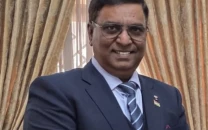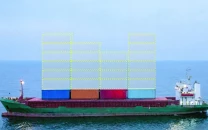Mining: an engine of progress
Pakistan has great future in mining because it has huge deposits of minerals

We grew up hearing about abundance of minerals in Pakistan and their potential to bring economic change to the country.
However, so far we have not really been able to harness them to bring that change. While they remained mostly buried below the ground, the country kept on sinking in the quagmire of debt which stood at $276 billion as of June 2020.
In addition to the heavy debt, the country is embroiled in many other social and economic issues. This makes it imperative to look for all options for accelerated value creation and wealth generation.
Many countries have used their mineral resources very effectively for the above purpose. A few examples are India, Brazil and Chile. India fetched foreign exchange worth $29 billion through the export of gems and jewellery in FY20 along with exports of other ores and value added minerals valuing at $4 billion. It became the world’s second largest crude steel producer in 2019 with production at 111.2 million tons. Our challenges in this regard are well known.
Brazil and Chile have also established themselves as mining giants while securing a stable income of more than $30 billion from exports.
Despite their oil wealth, the Gulf Cooperation Council (GCC) countries are also developing their mining industry at an accelerated pace. Saudi Arabia is leading the pack with its mining company Maaden, established in 1997 and already among the top 10 mining companies in the world. They have a highly diversified revenue stream. As part of the same, they have established two fully furnished industrial mining hubs.
This reminds me of Pakistan’s memorandum of understanding (MoU) with Saudi Arabia in February 2019, under which Riyadh intended to invest $2 billion in Pakistan’s mining sector. But we have not heard anything in this regard since long. Successful collaboration with Maaden can help the economy to take a giant leap forward.
Another such opportunity was Reko Diq. Unfortunately, the hysteria, instead of rational thinking, engulfed most of the discourse in 2011 which culminated in the eviction of foreign investor.
However, we got a “reality check” when the International Centre for Settlement of Investment Disputes (ICSID) in July 2019 slapped a fine of $6 billion. In all the cacophony, had pragmatism been allowed some room in 2011, the irritants in the agreement could easily have been negotiated and ironed out. Now, whenever we sit across the table with Tethyan Copper Company (TCC) – the operator of Reko Diq project – it would have the ICSID decision besides leveraging its position on the table.
Another such example is Tuwairqi Steel Mills established with an investment of $340 million with promise of another injection of $1 billion in the second phase. Its designed capacity was 1.28 million tons of high-grade steel while in the second phase the capacity would have grown to 1.5 million tons per year.
It has been lying idle since 2013, after successful performance testing, due to a dispute. While the government is striving for the revival of Pakistan Steel Mills, it is suggested that it may make some effort for reviving this asset too. It may require much less effort, resources and time. Its revival would give a major boost to the iron ore industry too.
There is market talk that this matter has also landed in ICSID. The issue deserves reconsideration with a fresh mind while taking a holistic view of the integrated value chain and its advantages for Pakistan.
Flawed agreements are always a nuisance, but letting them jeopardise core objectives is even worse.
I am sure that while planning our future in mining, we will keep in view the lessons learnt from the above experiences.
Pakistan has a great future in mining because it has huge deposits of minerals. These include world’s second largest coal and salt reserves and fifth largest copper and gold reserves.
The reserves of gemstones (fifth largest in the world) alone can prove to be a game changer. However, that would require a robust value chain based on modern technology, trained manpower and a disciplined mechanism for branding and marketing. Pakistan’s current exports of the same stand at only a few million dollars per annum. India has set up more than 3,000 offices outside the country for marketing its diamonds. Only last year it generated foreign exchange of $18 billion from exports and as per experts Pakistan’s gemstones are far superior in quality vis-a-vis Indian stones.
In any major mining-driven initiative, Pakistan Mineral Development Corporation (PMDC) can play a lead role, though it may need some capacity building in order to assume that role.
As a first step, it may review the existing revenue stream and identify margins for augmenting it. Key parameters for steering this exercise should be process optimisation, commercial agility, technology, intellectual capacity building and training.
Some key targets can be set to grab a bigger slice of the global salt market because of its slow reserves depletion rate vis-a-vis its size. At present, out of the global export volume of $3.1 billion, Pakistan’s share is $50 million with the Netherlands at the top with $290 million and India with $237 million.
The performance of a country possessing the second largest salt reserves definitely needs attention. Any increase in revenue would require implementation of a disciplined marketing system, identification and bridging of infrastructure gaps around mines and a robust inventory management system.
Any sizeable revenue stream in order to thrive always requires an effective communication infrastructure, modern technology and competent professionals.
Therefore, identifying and removing infrastructure bottlenecks, establishing a centre of excellence for developing quality manpower and forging partnerships with global operators and technology providers also need a prominent place in the “to do” list. The above are essential pre-requisites for entering the second phase ie long-term transformation. This, in my view, would require implementation of a growth strategy for PMDC for the next few decades, its conversion into a listed company and initiating a capacity gap audit while examining modern international mining companies.
A few other tasks include establishing PMDC as the centralised source of data archiving and digitising and establishing a framework for providing data on a commercial basis along with development of centralised hubs in mining districts by following in the footsteps of Maaden.
The third phase primarily pertains to consolidating the achievements of the previous two stages and building upon them further. By this stage, PMDC can consider offering services to other operators within and outside Pakistan for operation and maintenance, asset management, etc.
The experience of other countries which have achieved economic independence teaches us that the above is a guaranteed formula for wealth generation and that too at an accelerated pace. This is exactly what we need in view of our economic challenges.
The writer is a petroleum engineer and an oil and gas management professional
Published in The Express Tribune, February 1st, 2021.
Like Business on Facebook, follow @TribuneBiz on Twitter to stay informed and join in the conversation.



















COMMENTS
Comments are moderated and generally will be posted if they are on-topic and not abusive.
For more information, please see our Comments FAQ